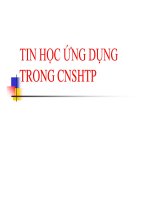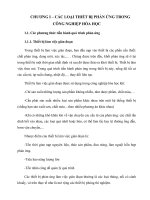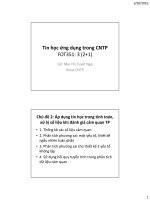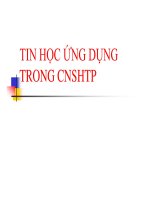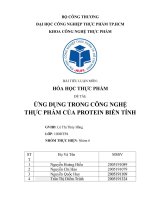Tin học ứng dụng trong công nghệ hóa học Parallelprocessing 12 basicparallelalgorithms
Bạn đang xem bản rút gọn của tài liệu. Xem và tải ngay bản đầy đủ của tài liệu tại đây (529.58 KB, 30 trang )
Parallel Algorithms
Thoai Nam
Outline
Introduction
to parallel algorithms
development
Reduction algorithms
Broadcast algorithms
Prefix sums algorithms
Khoa Công Nghệ Thông Tin – Đại Học Bách Khoa Tp.HCM
-2-
Introduction to Parallel
Algorithm Development
Parallel algorithms mostly depend on destination
parallel platforms and architectures
MIMD algorithm classification
–
–
–
Pre-scheduled data-parallel algorithms
Self-scheduled data-parallel algorithms
Control-parallel algorithms
According to M.J.Quinn (1994), there are 7 design
strategies for parallel algorithms
Khoa Công Nghệ Thông Tin – Đại Học Bách Khoa Tp.HCM
-3-
Basic Parallel Algorithms
3 elementary problems to be considered
–
–
–
Reduction
Broadcast
Prefix sums
Target Architectures
–
–
–
–
Hypercube SIMD model
2D-mesh SIMD model
UMA multiprocessor model
Hypercube Multicomputer
Khoa Công Nghệ Thông Tin – Đại Học Bách Khoa Tp.HCM
-4-
Reduction Problem
Description: Given n values a0, a1, a2…an-1
associative operation , let’s use p processors
to compute the sum:
S = a0 a1 a2 … an-1
Design strategy 1
–
“If a cost optimal CREW PRAM algorithms exists
and the way the PRAM processors interact through
shared variables maps onto the target architecture, a
PRAM algorithm is a reasonable starting point”
Khoa Công Nghệ Thông Tin – Đại Học Bách Khoa Tp.HCM
-5-
Cost Optimal PRAM Algorithm
for the Reduction Problem
Cost optimal PRAM algorithm complexity:
O(logn) (using n div 2 processors)
Example for n=8 and p=4 processors
a0
j=0
P0
j=1
P0
j=2
P0
a1
a2
P1
a3
a4
a5
P2
a6
a7
P3
P2
Khoa Công Nghệ Thông Tin – Đại Học Bách Khoa Tp.HCM
-6-
Cost Optimal PRAM Algorithm for
the Reduction Problem(cont’d)
Using p= n div 2 processors to add n numbers:
Global a[0..n-1], n, i, j, p;
Begin
spawn(P0, P1,… ,,Pp-1);
for all Pi where 0 ≤ i ≤ p-1 do
for j=0 to ceiling(logp)-1 do
if i mod 2j =0 and 2i + 2j < n then
a[2i] := a[2i] a[2i + 2j];
endif;
endfor j;
endforall;
End.
Notes: the processors communicate in a biominal-tree pattern
Khoa Công Nghệ Thông Tin – Đại Học Bách Khoa Tp.HCM
-7-
Solving Reducing Problem on
Hypercube SIMD Computer
P6
P4
P0
P0
P2
P7
P5
P1
P2
P0
P3
P1
P1
P3
Step 1:
Step 2:
Step 3:
Reduce by dimension j=2
Reduce by dimension j=1
Reduce by dimension j=0
The total sum will be at P0
Khoa Công Nghệ Thông Tin – Đại Học Bách Khoa Tp.HCM
-8-
Solving Reducing Problem on
Hypercube SIMD Computer (cond’t)
Allocate
workload for
each
processors
Using p processors to add n numbers ( p << n)
Global j;
Local local.set.size, local.value[1..n div p +1], sum,
tmp;
Begin
spawn(P0, P1,… ,,Pp-1);
for all Pi where 0 ≤ i ≤ p-1 do
if (i < n mod p) then local.set.size:= n div p + 1
else local.set.size := n div p;
endif;
sum[i]:=0;
endforall;
Khoa Công Nghệ Thông Tin – Đại Học Baùch Khoa Tp.HCM
-9-
Solving Reducing Problem on
Hypercube SIMD Computer (cond’t)
Calculate the
partial sum for
each processor
for j:=1 to (n div p +1) do
for all Pi where 0 ≤ i ≤ p-1 do
if local.set.size ≥ j then
sum[i]:= sum local.value [j];
endforall;
endfor j;
Khoa Công Nghệ Thông Tin – Đại Học Bách Khoa Tp.HCM
-10-
Solving Reducing Problem on
Hypercube SIMD Computer (cond’t)
Calculate the total
sum by reducing
for each
dimension of the
hypercube
for j:=ceiling(logp)-1 downto 0 do
for all Pi where 0 ≤ i ≤ p-1 do
if i < 2j then
tmp := [i + 2j]sum;
sum := sum tmp;
endif;
endforall;
endfor j;
Khoa Công Nghệ Thông Tin – Đại Học Bách Khoa Tp.HCM
-11-
Solving Reducing Problem on
2D-Mesh SIMD Computer
A 2D-mesh with p*p processors need at least 2(p-1) steps to
send data between two farthest nodes
The lower bound of the complexity of any reduction sum
algorithm is 0(n/p2 + p)
Example: a 4*4 mesh
need 2*3 steps to get
the subtotals from the
corner processors
Khoa Công Nghệ Thông Tin – Đại Học Bách Khoa Tp.HCM
-12-
Solving Reducing Problem on
2D-Mesh SIMD Computer(cont’d)
Example: compute the total sum on a 4*4 mesh
Stage 1
Stage 1
Stage 1
Step i = 3
Step i = 2
Step i = 1
Khoa Công Nghệ Thông Tin – Đại Học Bách Khoa Tp.HCM
-13-
Solving Reducing Problem on
2D-Mesh SIMD Computer(cont’d)
Example: compute the total sum on a 4*4 mesh
Stage 2
Stage 2
Stage 2
Step i = 3
Step i = 2
Step i = 1
(the sum is at P1,1)
Khoa Công Nghệ Thông Tin – Đại Học Bách Khoa Tp.HCM
-14-
Solving Reducing Problem on
2D-Mesh SIMD Computer(cont’d)
Stage 1:
Pi,1 computes
the sum of all
processors in
row i-th
Summation (2D-mesh SIMD with l*l processors
Global i;
Local tmp, sum;
Begin
{Each processor finds sum of its local value
code not shown}
for i:=l-1 downto 1 do
for all Pj,i where 1 ≤ i ≤ l do
{Processing elements in colum i active}
tmp := right(sum);
sum:= sum tmp;
end forall;
endfor;
Khoa Công Nghệ Thông Tin – Đại Học Bách Khoa Tp.HCM
-15-
Solving Reducing Problem on
2D-Mesh SIMD Computer(cont’d)
Stage2:
Compute the
total sum and
store it at P1,1
for i:= l-1 downto 1 do
for all Pi,1 do
{Only a single processing element active}
tmp:=down(sum);
sum:=sum tmp;
end forall;
endfor;
End.
Khoa Công Nghệ Thông Tin – Đại Học Bách Khoa Tp.HCM
-16-
Solving Reducing Problem on
UMA Multiprocessor Model(MIMD)
Easily to access data like PRAM
Processors execute asynchronously, so we must ensure
that no processor access an “unstable” variable
Variables used:
Global
a[0..n-1],
{values to be added}
p,
{number of proeessor, a power of 2}
flags[0..p-1],
{Set to 1 when partial sum available}
partial[0..p-1],
{Contains partial sum}
global_sum;
{Result stored here}
Local local_sum;
Khoa Công Nghệ Thông Tin – Đại Học Bách Khoa Tp.HCM
-17-
Solving Reducing Problem on
UMA Multiprocessor Model(cont’d)
Example for UMA multiprocessor with p=8 processors
Stage 2
P0
P1
P2
P3
P4
P5
P6
P7
Step j=8
Step j=4
Step j=2
Step j=1
The total sum is at P0
Khoa Công Nghệ Thông Tin – Đại Học Bách Khoa Tp.HCM
-18-
Solving Reducing Problem on UMA
Multiprocessor Model(cont’d)
Stage 1:
Each processor
computes the
partial sum of n/p
values
Summation (UMA multiprocessor model)
Begin
for k:=0 to p-1 do flags[k]:=0;
for all Pi where 0 ≤ i < p do
local_sum :=0;
for j:=i to n-1 step p do
local_sum:=local_sum a[j];
Khoa Công Nghệ Thông Tin – Đại Học Bách Khoa Tp.HCM
-19-
Solving Reducing Problem on UMA
Multiprocessor Model(cont’d)
j:=p;
while j>0 do begin
Stage 2:
Compute the total sum
Each processor
waits for the partial
sum of its partner
available
if i ≥ j/2 then
partial[i]:=local_sum;
flags[i]:=1;
break;
else
while (flags[i+j/2]=0) do;
local_sum:=local_sum partial[i+j/2];
endif;
j=j/2;
end while;
if i=0 then global_sum:=local_sum;
end forall;
End.
Khoa Công Nghệ Thông Tin – Đại Học Baùch Khoa Tp.HCM
-20-
